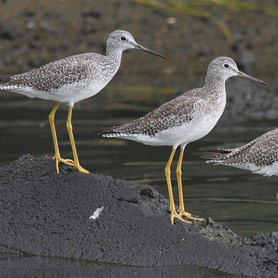The Jamaica Bay ecosystem, located in Brooklyn and Queens, includes about 13,000 acres of salt marsh, uplands, mudflats and open water. This is about half of its original size; the Bay was once 25,000 acres, with its marshes and tidal creeks extending well into what are now heavily populated areas of New York City. Dredging and filling over the past 150 years have erased much of the extensive marshes and severely altered the landscape. As early as 1920, Jamaica Bay became so polluted that oysters disappeared and shellfishing was closed; it still remains closed today. Jamaica Bay was once a shallow bay with an average depth of about 2 feet; deepening channels to allow for shipping increased the average depth to about 16 feet today. In the 1950s, over 4,500 acres were filled in to build Idlewild (now JFK) Airport. Unfortunately, it wasn’t until 1974 that New York State passed a law protecting these ecologically valuable marshes. Scientific studies now show that marshes are among the most productive ecosystems on earth. The Spartina grasses form peat barriers protect the mainland from storm surge, inject nutrients to the bay and ocean and provide food for many species of birds and other wildlife. They also act as a sheltering nursery for many species of finfish.
For almost three centuries, Jamaica Bay was known for the abundance, variety and quality of its fin and shellfish (Black, 1981). Studies undertaken by the New York Aquarium and National Park Service (Riepe & Tanacredi, 1986) have identified over 80 species of finfish found in Jamaica Bay. Other anecdotal reports have added another 20 species, mostly tropical strays, over the last 20 years. Jamaica Bay is also known for its abundance and diversity of birdlife. Over 330 species have been recorded here over the past 45 years. Most of them are migratory, using the bay as a stopover during long flights north and south each year. Birders from the tri-state area regard Jamaica Bay as one of the best spots to see birds in the northeast. Beautiful egrets, herons, glossy ibis, oystercatchers, terns and majestic ospreys nest within the refuge and can be seen from spring through fall.
In the early 1950s, the central section of the bay (9,155 acres) was declared a wildlife refuge and was managed by the NYC Department of Parks and Recreation. In 1972, this land as well as most of the bay’s shoreline was deeded over to the National Park Service as part of Gateway National Recreation Area. This past August, the refuge opened a beautiful new visitor center that has a “state-of-the-art” environmentally friendly, green design. There are about 5 miles of trails that take you around the West Pond and through upland woodlands. September and October are peak months for viewing many species of birds as they migrate south through the city.
Despite a great interest and current agency policies toward restoring natural areas, the bay is facing a very critical period. Sea level rise plus polluted runoff from NYC combined sewer overflows, sewage treatment plant effluent, and continued development in the watershed may be leading to the demise of the remaining marshes in the bay. It is estimated that the bay is losing about 40+ acres of salt marsh yearly. Currently, the Army Corps of Engineers is restoring (at a cost of approximately 16 million dollars) about 60 acres of marsh in the north central section of the bay at Eldert’s Point. Will the National Park Service and other agencies have the will and determination to fight for more funding to continue this expensive process? Will it work in the long run? The future of the bay remains uncertain…
To visit Jamaica Bay National Wildlife Refuge, take Woodhaven Boulevard south, where eventually it will change into to Cross Bay Boulevard. After crossing over the Addabbo Bridge and traveling another mile, turn right at a traffic light into the refuge parking lot. The Q53 bus, which you may board on the south side of Queens Boulevard at Woodhaven Boulevard, will also drop you off at the parking lot entrance.
To find out more about Gateway events, write for a program guide:
Gateway National Recreation Area
Jamaica Bay Unit
Floyd Bennett Field
Brooklyn, NY 11234
For information about nature hikes and sunset cruises in the NYC area, call the American Littoral Society (718) 318-9344 or check www.alsnyc.org.
Don Riepe runs the Jamaica Bay Guardian program and is the director of the American Littoral Society's Northeast Chapter.




